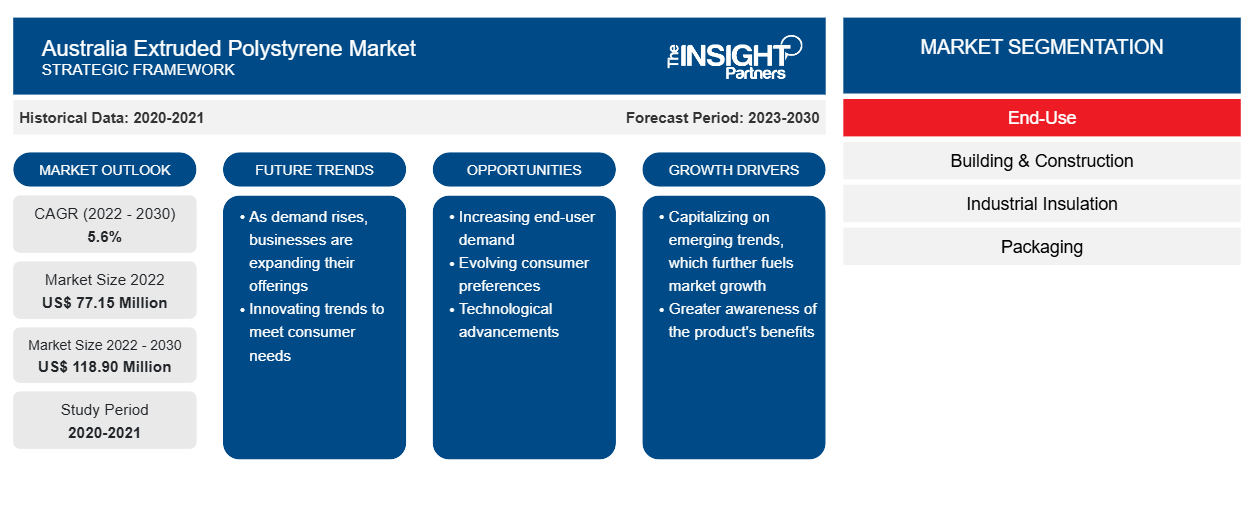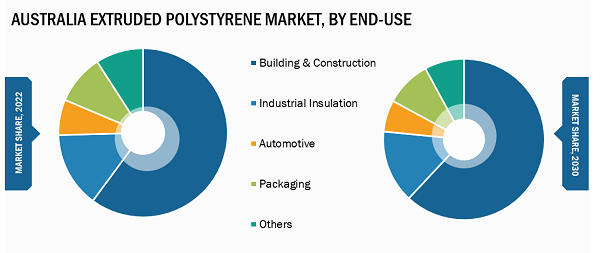The Australia extruded polystyrene market size is expected to reach US$ 118.90 million by 2030 from US$ 77.15 million in 2022; the market is estimated to register a CAGR of 5.6% from 2022 to 2030.
Market Insights and Analyst View:
Extruded polystyrene is an efficient insulation material that has been growing in popularity. It is widely used in the construction of basements, floors, foundations, walls, roofs, and others. The polystyrene beads are melted and then extruded through a dye to form a continuous closed-cell structure. The resulting boards have a high R-value and good moisture resistance. It also has high compressive strength and is easy to handle and install. The growing construction activities in Australia drive the need for insulation materials, thereby propelling the growth of the Australia extruded polystyrene market.
Growth Drivers and Challenges:
According to the International Trade Administration (ITA), the Australian building & construction industry conducts over US$ 162 billion worth of building and construction work each year. The industry accounts for around 10% of GDP, thus being the fifth-largest industry in the economy. Factors, including population growth, urbanization, and infrastructure demand, have resulted in the development of Australia’s construction industry. Further, Australia's building & construction sector is renowned for its resilience and adaptability toward technological advancements. The building and construction have progressively adopted innovative techniques and technologies to meet evolving market demands and environmental concerns. The sector also continues to attract investments and provides substantial employment opportunities in the country. Extruded polystyrene is an essential material used in building and construction, majorly in foundations, basements, floors, walls, roofs, pipelines, roads, and railways. It is valued for its insulating properties, as it offers durability, energy savings, and moisture control. It is a thermoplastic polymer consisting of a closed-cell structure. Extruded polystyrene is often stronger, with a higher mechanical performance. It is recognized as a resilient and robust construction material boasting high compressive strength and superior thermal performance. The high-density cell structure of XPS makes it practically impervious to water. As extruded polystyrene foam consists of a higher R-value than other types of construction boards, it offers better resistance to heat transfer. Furthermore, the XPS utilized in the building & construction industry helps consumers lower their energy bills by reducing air leaks and decreasing the transfer of heat between indoor and outdoor environments. As moisture can increase mold and mildew in the building envelope when it passes through the walls, extruded polystyrene boards, when installed properly, provide a layer of protection against moisture. Owing to all these benefits, extruded polystyrene has become the number one choice for home builders, specifiers, architects, and engineers in Australia in recent years. Thus, the growing residential, commercial, and industrial construction activities are contributing to the growing Australia extruded polystyrene market.
Extruded polystyrene is made from materials such as general-purpose polystyrene, blowing agents, nucleating agents, flame retardants, etc. In the production of extruded polystyrene boards, hydrochlorofluorocarbons are used, which deplete the ozone layer. General-purpose polystyrene used in making extruded polystyrene is made from petrochemicals and is arduous to dispose of. The increasing use of plastics has led to extensive plastic landfills. A small percentage of plastic waste is recycled, and the remaining waste goes to landfills or incineration processes. The waste results in deteriorating soil and underground water bodies and causes global warming. Further, polystyrene is also known as a common source of global marine pollution. According to cleanup groups of British Columbia, extruded polystyrene materials account for 50–70% of marine pollution debris collected by coastal cleanup groups. As the most common forms of garbage found on coastlines, XPS debris creates serious economic and environmental problems. These materials adversely impact human health, wildlife, marine life, and the environment. Therefore, the harmful impact of extruded polystyrene and its raw materials on the environment hampers the Australia extruded polystyrene market growth.
Customize This Report To Suit Your Requirement
You will get customization on any report - free of charge - including parts of this report, or country-level analysis, Excel Data pack, as well as avail great offers and discounts for start-ups & universities
Australia Extruded Polystyrene Market: Strategic Insights

- Get Top Key Market Trends of this report.This FREE sample will include data analysis, ranging from market trends to estimates and forecasts.
You will get customization on any report - free of charge - including parts of this report, or country-level analysis, Excel Data pack, as well as avail great offers and discounts for start-ups & universities
Australia Extruded Polystyrene Market: Strategic Insights

- Get Top Key Market Trends of this report.This FREE sample will include data analysis, ranging from market trends to estimates and forecasts.
Report Segmentation and Scope:
The Australia Extruded Polystyrene Market Analysis and Forecast to 2030 is a specialized and in-depth study with a significant focus on market trends and growth opportunities. The report aims to provide an overview of the market with detailed market segmentation by end-use. The market has witnessed high growth in the recent past and is expected to continue this trend during the forecast period. The report provides key statistics on the use of extruded polystyrene in Australia. In addition, the Australia extruded polystyrene market report provides a qualitative assessment of various factors impacting the market performance in Australia and a comprehensive analysis of the leading market players and their key strategic developments. Several analyses on the market dynamics are also included to help identify the key driving factors, Australia extruded polystyrene market trends, and lucrative opportunities that would, in turn, aid in identifying the major revenue pockets.
The Australia extruded polystyrene market forecast is estimated on the basis of various secondary and primary research findings, such as key company publications, association data, and databases. Further, the ecosystem analysis and Porter's five forces analysis provide a 360-degree view of the market, which helps understand the entire supply chain and various factors affecting the Australia extruded polystyrene market performance.
- This FREE sample will include data analysis, ranging from market trends to estimates and forecasts.
Segmental Analysis:
The Australia extruded polystyrene market is segmented on the basis of end-use. Based on end-use, the market is segmented into building & construction, industrial insulation, packaging, automotive, and others. The industrial insulation segment held a significant portion of the Australia extruded polystyrene market share in 2022. Factories, manufacturing plants, warehouses, and other industrial facilities have specific insulation requirements to ensure optimal operational conditions. XPS, known for its excellent thermal insulation properties, is increasingly being used in the industrial sector to enhance energy efficiency and maintain controlled temperatures within these facilities. In industrial settings, where precise temperature control is essential for processes and equipment, XPS serves as a reliable solution to minimize heat transfer. This contributes to energy saving and aids in maintaining consistent production environments. Additionally, industrial facilities are exposed to varying weather conditions and may face challenges related to moisture ingress. XPS acts as a protective barrier; it helps prevent water damage and ensures the longevity of insulation systems in these environments. The materials' ease of installation and versatility also influence the industrial sector's reliance on XPS. In complex industrial settings, where insulation needs can be diverse and intricate, XPS offers flexibility in application, adapting to different surfaces and structures. Furthermore, industries focus on sustainability and energy conservation, and XPS aligns with these objectives. Its recyclability and long-lasting performance make it an attractive choice for industrial insulation, meeting the functional and environmental criteria the sector increasingly values.
Australia Extruded Polystyrene Market Share – by End-Use, 2022 and 2030


- This FREE sample will include data analysis, ranging from market trends to estimates and forecasts.
Regional Analysis:
The thriving building & construction and automotive sectors in Australia are major contributors to the growing demand for extruded polystyrene (XPS). According to The Australian Industry and Skills Committee (AISC), the construction industry generates more than US$ 250 billion in revenue, producing around 9% of Australia's GDP, with a projected annual growth rate of 2.4% by 2025. XPS is widely used as an insulation material in construction due to its excellent thermal performance and moisture resistance. With an increasing focus on energy-efficient buildings and sustainable construction practices, builders and contractors in Australia are turning to XPS to meet these requirements. According to the New Zealand Trade and Enterprise, Australia's population is expected to reach 9.7 million in the next decade due to rising migration. An upsurging population leads to greater demand for housing. In addition, increasing single-person households is also expected to drive the requirement for housing.
Australia's climate variability, with hot summers and cool winters, drives the need for effective insulation materials. XPS provides insulation against temperature extremes and acts as a barrier to moisture, making it a preferred choice in various construction applications. The country's infrastructure development projects, such as residential and commercial buildings, also contribute to the rising demand for XPS. As urbanization continues and more structures are erected, the demand for reliable and durable insulation materials such as XPS is on the rise. Further, the government's support for energy-efficient buildings is the other key driver for the Australia extruded polystyrene market growth. For instance, Sustainability Victoria's Energy Efficient Office Buildings program demonstrates that up to 29% of energy savings can be attained across mid-tier office buildings via building tuning and cost-effective energy efficiency measures. In Australia, the building industry accounts for 23% of greenhouse gas emissions and around 19% of total energy consumption. Recent modeling suggests that the building sector can deliver a 23% reduction in emissions by 2030 and a 55% reduction by 2050. The awareness of environmental concerns and the push for sustainable practices have led to increased adoption of XPS, known for its recyclability and long lifespan. This aligns with Australia's commitment to eco-friendly building solutions and a greener construction industry.
Industry Developments and Future Opportunities:
A few initiatives by key players operating in the Australia extruded polystyrene market, as per press releases, are listed below:
- In June 2023, DuPont Styrofoam Brand ST-100 Extruded Polystyrene Foam (XPS) received the 2023 ACC Sustainability Leadership Award in the Environmental Protection category.
- In October 2022, BEWI completed the acquisition of Jackon. The company aims to create strong synergies across the value chain through this acquisition. BEWI and JACKON have around 70 facilities, in addition to 12 facilities owned through minority-owned companies operating in 13 European countries.
Competitive Landscape and Key Companies:
DuPont de Nemours Inc, Redbak International, Stile Board Pty Ltd, Bewi ASA, Foamex Group Pty Ltd, Kingspan Group Plc, Koolfoam Pty Ltd, The Foam Co, Owens Corning, and BASF SE are among the key players profiled in the Australia extruded polystyrene market report. The market players focus on providing high-quality products to fulfill customer demand.
Australia Extruded Polystyrene Report Scope
| Report Attribute | Details |
|---|---|
| Market size in 2022 | US$ 77.15 Million |
| Market Size by 2030 | US$ 118.90 Million |
| CAGR (2022 - 2030) | 5.6% |
| Historical Data | 2020-2021 |
| Forecast period | 2023-2030 |
| Segments Covered |
By End-Use
|
| Regions and Countries Covered | Australia
|
| Market leaders and key company profiles |
|
- Historical Analysis (2 Years), Base Year, Forecast (7 Years) with CAGR
- PEST and SWOT Analysis
- Market Size Value / Volume - Regional, Country
- Industry and Competitive Landscape
- Excel Dataset
Recent Reports
Testimonials
Reason to Buy
- Informed Decision-Making
- Understanding Market Dynamics
- Competitive Analysis
- Identifying Emerging Markets
- Customer Insights
- Market Forecasts
- Risk Mitigation
- Boosting Operational Efficiency
- Strategic Planning
- Investment Justification
- Tracking Industry Innovations
- Aligning with Regulatory Trends





















 Get Free Sample For
Get Free Sample For